Some of us simply enjoy seeing evocative visuals in worship. Loaves of bread somehow attached to a large cross make us think about the Bread of Life broken for us. Hundreds of fabric strips woven together—lace, satin, flannel, gingham—remind us how God joins stories and lives into one body.
But others of us scrutinize worship visuals and immediately start asking questions. Where did the idea come from? Who made it? What materials did they use? Why did they make those choices? How did they construct and display it? When and how did the creators envision the work would be used in worship?
Linda Witte Henke belongs to the second group. She pastored two Lutheran congregations before becoming a full-time liturgical textile artist. At a recent Calvin Symposium on Worship, she described seven ways for artists and teams to collaborate on visual arts projects for worship. Each model requires setting aside ego for the common goal of enhancing Christian worship.
Henke says that each model involves collaboration “not only with people,” but also with “a particular space to discern appropriate options, liturgical seasons to identify relevant themes, and sacred texts, including the lectionary texts that shape weekly worship,” she explains.
Working with an artist
How your congregation, group or school works with an artist depends on who designs and executes the project. Here are four options:
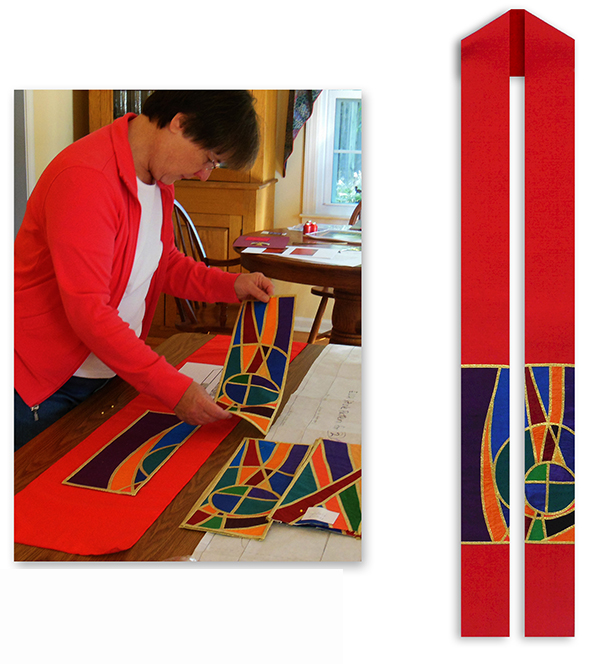 1. A person or team works with an artist to design and execute the project
1. A person or team works with an artist to design and execute the project
Before Elizabeth A. Eaton was installed as presiding bishop of the Evangelical Lutheran Church of America (ELCA), Henke created new vestments for the occasion. Denominational leaders said they wanted liturgical garments grounded in ELCA’s tradition of liturgical worship, yet celebrating the newness of installing the first female bishop. They chose Henke’s “Festive Red” design, and she and her studio associate, Christine Felde, created the collection. The red of the vestments worked well with the rose window blazing above the altar in the University of Chicago’s Rockefeller Chapel. The vestments’ abstract imagery (globe/Creator, cross/Son, flame/Spirit) lent a contemporary touch. (Photo: Christine Felde making Festive Red stoles. Photo by Linda Henke.)
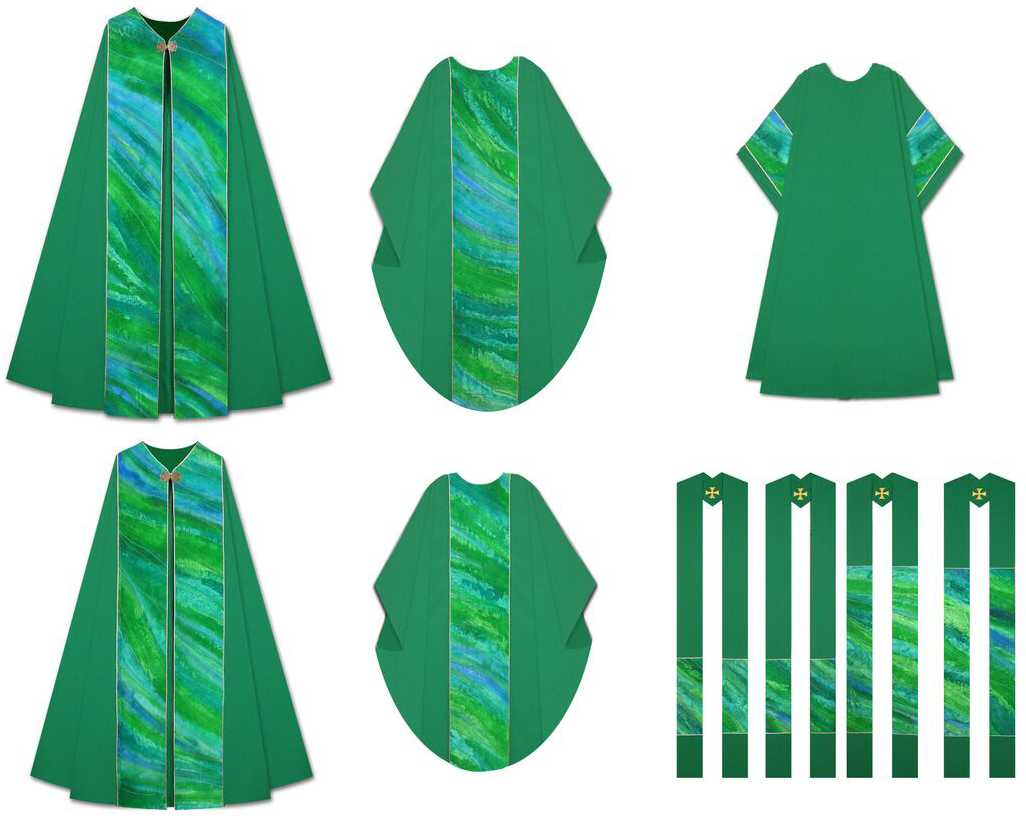 Henke followed a similar process for her “Living Water” vestments and paraments (banners, pulpit and communion tablecloths). These were commissioned in memory of Peter Perella, ELCA’s former director of worship. The background fabric is green for use in Ordinary Time. Hand-painted blue and green silk on each piece references Jesus’ encounter with the Samaritan woman at the well. (Photo: Living Water vestments. Photo by Phil and Linda Henke.)
Henke followed a similar process for her “Living Water” vestments and paraments (banners, pulpit and communion tablecloths). These were commissioned in memory of Peter Perella, ELCA’s former director of worship. The background fabric is green for use in Ordinary Time. Hand-painted blue and green silk on each piece references Jesus’ encounter with the Samaritan woman at the well. (Photo: Living Water vestments. Photo by Phil and Linda Henke.)
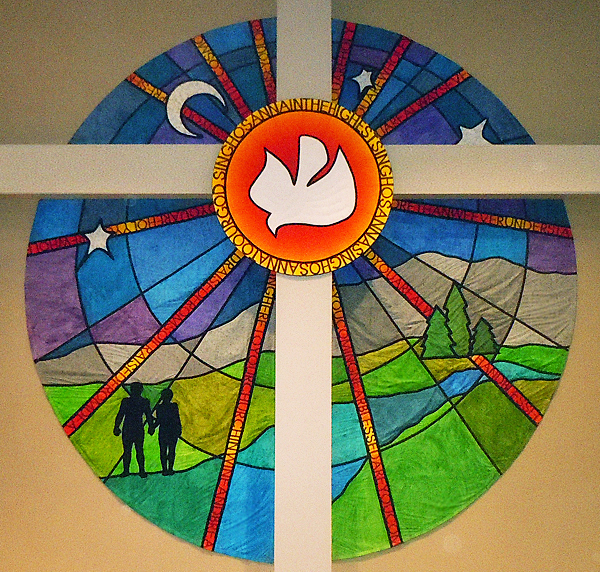 2. A person or team works with an artist to design and collaboratively execute the project.
2. A person or team works with an artist to design and collaboratively execute the project.
Carmel Lutheran Church in Carmel, Indiana, wanted a visual arts project to fill a blank wall in the space used for the congregation’s contemporary worship service. The piece had to fit their 2012 summer Fine Arts Academy theme—the cosmic power of God—and be carried out by the Academy’s 150+ kids and staff. They worked with Henke to develop a 19-foot circle depicting creation and integrated with the wall’s cross-shaped support beams. All ages worked together to paint the sections of “Holy, Wholly, Whole” on 40 yards of fabric. They also created doodles that were screen printed onto background colors. (Photo: Completed Holy, Wholly, Whole. Photo by Linda and Phil Henke.)
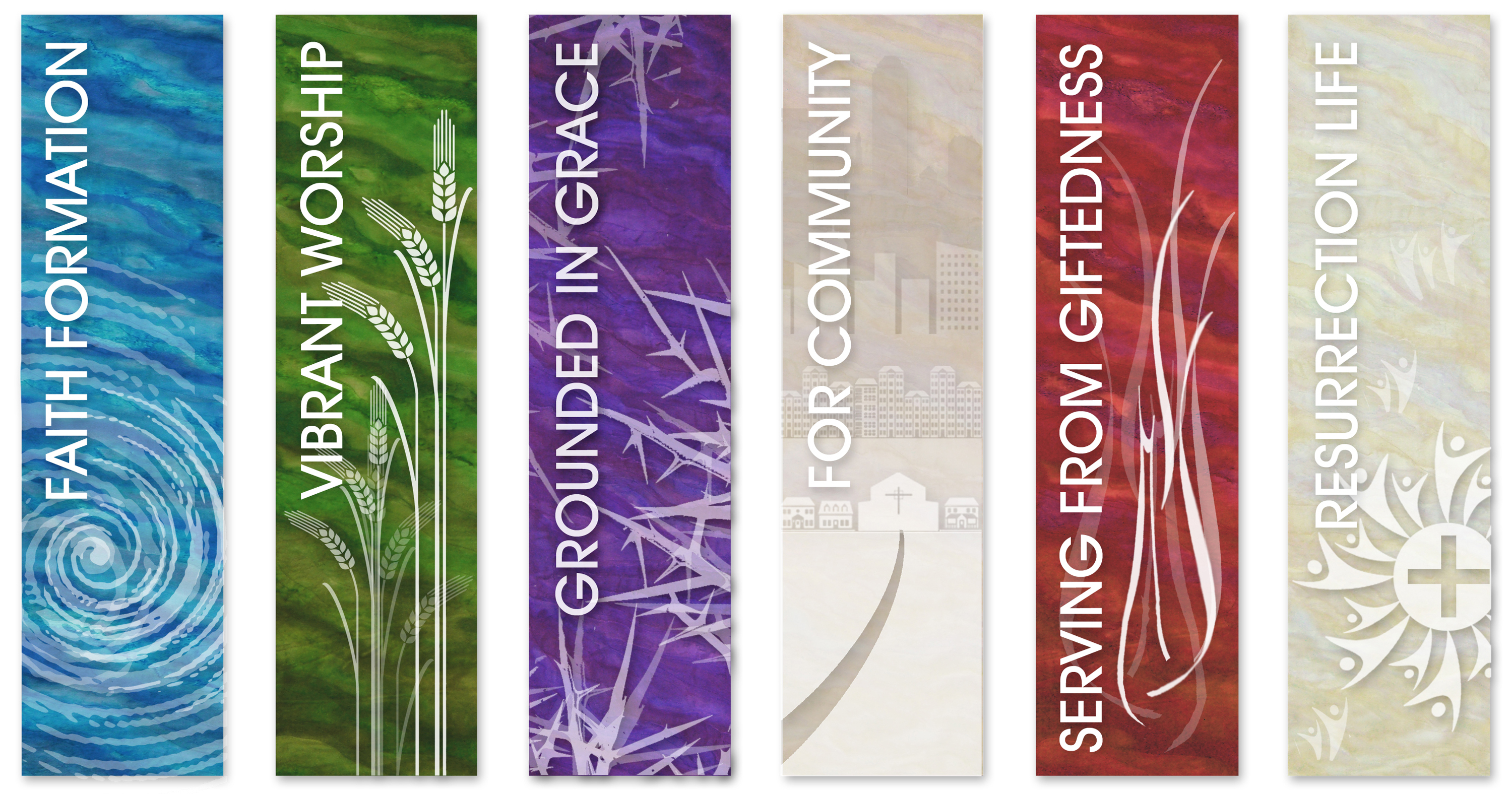 3. A person or team designs the project, and then contracts with professional artists or crafts persons to execute all or part of the project.
3. A person or team designs the project, and then contracts with professional artists or crafts persons to execute all or part of the project.
Resurrection Lutheran Church in Indianapolis, Indiana, asked Henke to create a collection of large banners for their new worship space. They wanted the banners to reinforce their core values, such as vibrant worship and promoting community. Henke suggested linking those values with liturgical seasons. DPI San Francisco printed her designs on fabric. The Faith Formation banner, with its spiral design on Advent blue, sparks musings about Christ’s birth and Christ being formed in us. The Grounded in Grace banner features thorns on Lenten purple, and Serving from Giftedness has flames on Pentecost red. (Photo: All six Resurrection Lutheran banners. Photos by Phil and Linda Henke.)
4. A person or team designs the project, and then contracts with professional artists or crafts persons to help execute the project.
A church in Minnesota requested a proposal for a piece that would hang in its worship space during Ordinary Time. The director of music and fine arts ministries wanted a Tree of Life design somehow related to summer and fall (the months of Ordinary Time) as well as Reformation Day and All Saints Day.
Henke has proposed a circular stylized Tree of Life form cut from lightweight composite board. She designed two reversible fabric circles to hang behind the tree. One circle shows spring and fall leaves. The other shows vivid red foliage for Reformation Day and shimmering gold for All Saints Day. If the church approves her design, then Henke will contract with a woodworker to create the Tree of Life structure and a commercial printer to reproduce her designs on fabric.
Deciding whether you should commission a professional artist often depends on whether or not you have the technical gifts to do the project. “The more permanent the arts project, the higher the expertise you’ll need,” Henke says.
Working with teams
Working together on a large visual arts project is often very meaningful for congregations and other teams. Henke describes three options:
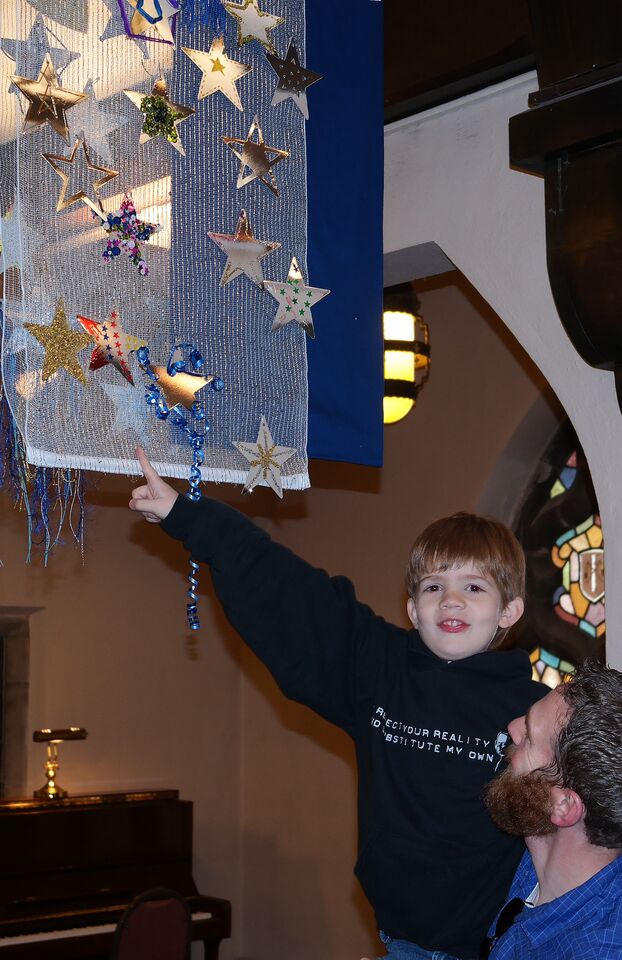 1. A team works together to design the project and engage broad collaborative participation in executing all or part of the project.
1. A team works together to design the project and engage broad collaborative participation in executing all or part of the project.
Henke serves in the liturgical arts ministry of Bethlehem Lutheran Church in Indianapolis, Indiana. Her team designed banner projects for each liturgical season, and several projects included congregation-wide participation. All ages created stars that were attached to translucent panels that overlaid Advent blue and Christmas white banners. They inked their thumbprints onto crosses used in Lenten banners. Red is the liturgical color for Pentecost and Reformation Day, so worshipers wore red to those services. (Photo: Boy points to star at Bethlehem Lutheran. Photo by Phil and Linda Henke.)
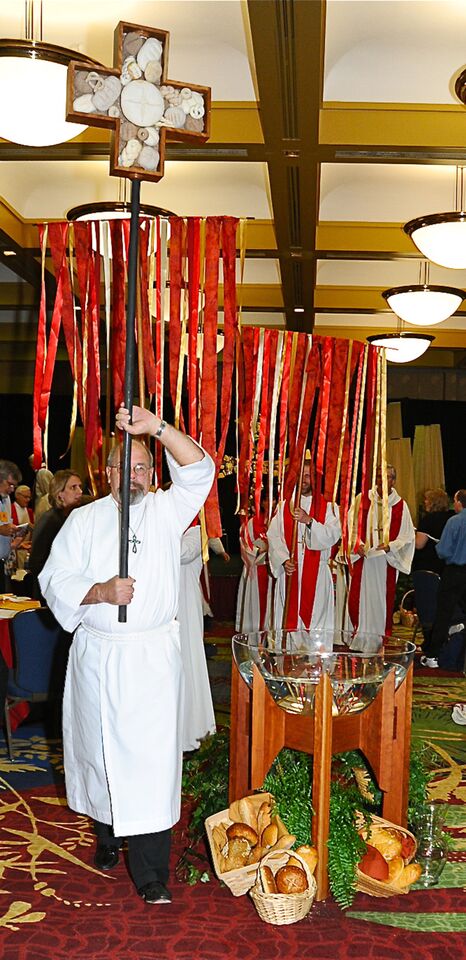 2. One team develops the project design, and another team executes the project.
2. One team develops the project design, and another team executes the project.
In 2003, the five-state, 182-congregation ELCA Rocky Mountain Synod did a series of worship renewal events called “One Bread, One Body.” They designed each event to include one plenary presentation, break-out sessions, a shared meal, a marketplace of ministry resources and closing worship. The One Bread, One Body team worked with Henke to design Pentecost and Advent banners and a processional cross. Henke designed the banners, and another artist created them. She designed the cross and created bread forms—challah, pretzels, Irish soda bread and more—with bread dough clay. A woodworker built a wooden cruciform frame to hold the bread dough atop the processional cross. (Photo: One Bread One Body Pentecost banners and processional cross. Photo courtesy of ELCA Rocky Mountain Synod.)
3. A visioning person or group offers ideas for consideration, and then a team develops a design that integrates one of more of the vision ideas. That same team either completes the project or finds others to do so.
Linda Witte Henke chairs ELCA Indiana-Kentucky Synod’s worship committee. For its annual meetings, the synod books venues large enough to hold people from its 190 congregations plus several camps and campus ministries. The worship committee lamented that these cavernous spaces aren’t ideal for synodical worship services, so Henke came up with a visual arts project, “Bound Together,” to embody how their synod joins diverse people, places and gifts.
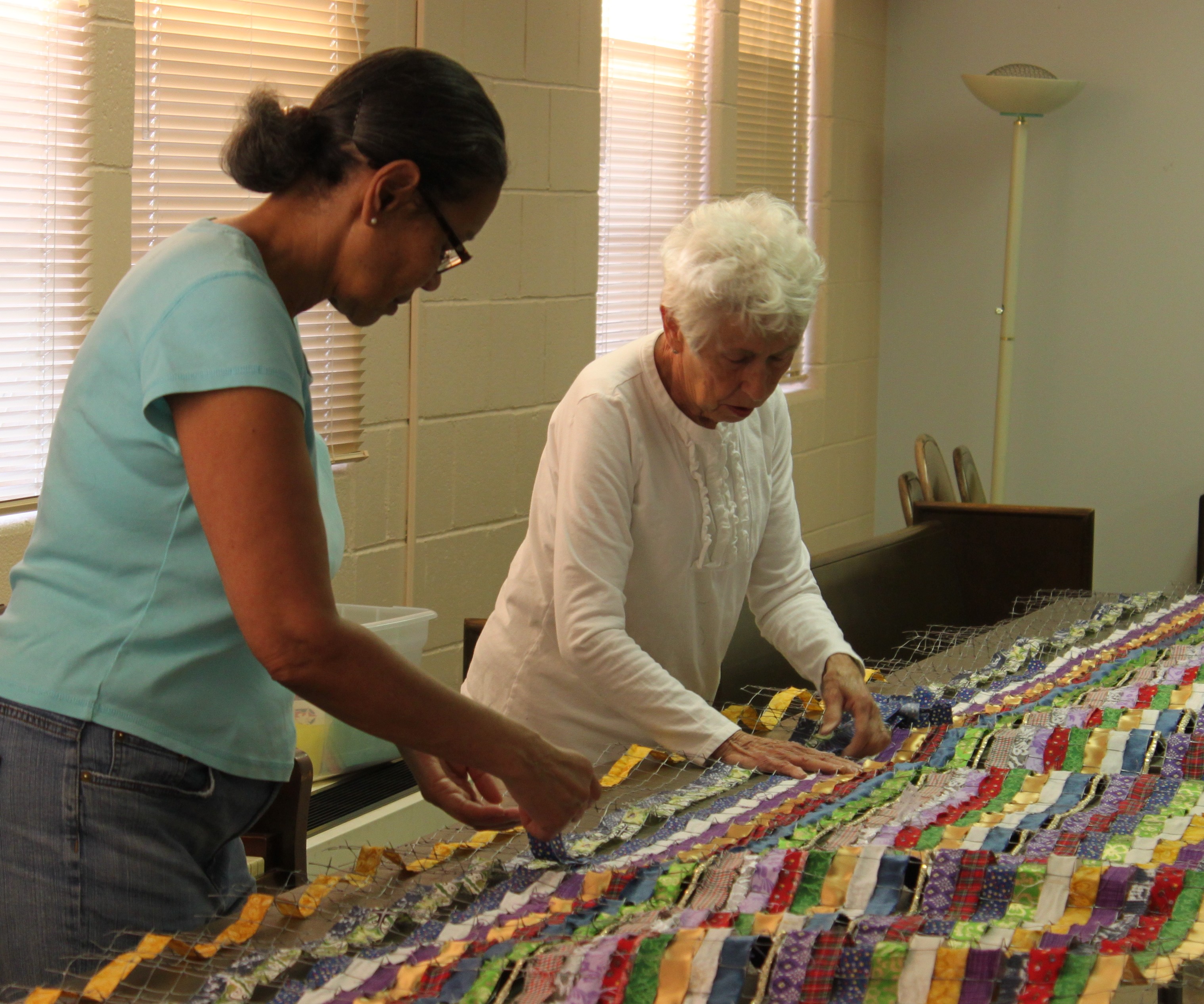 Each of the synod’s ten conferences gathered fabric strips in liturgical colors, using leftover cloth from other church projects, children’s pajamas, work shirts, wedding gowns, prom dresses and vintage prints. People of all ages wove the strips into squares of poultry netting, and other volunteer teams joined the squares together into a 22-foot-by-22-foot tapestry and paraments. (Photo: Two women weaving Bound Together. Photo by Linda Henke.)
Each of the synod’s ten conferences gathered fabric strips in liturgical colors, using leftover cloth from other church projects, children’s pajamas, work shirts, wedding gowns, prom dresses and vintage prints. People of all ages wove the strips into squares of poultry netting, and other volunteer teams joined the squares together into a 22-foot-by-22-foot tapestry and paraments. (Photo: Two women weaving Bound Together. Photo by Linda Henke.)
No room for big egos
“There’s no room for ego or for a person looking to stand out in visual arts projects for worship. I’ve learned to surrender control over outcomes in large projects, such as ‘Holy, Wholly, Whole’ at the Carmel Lutheran summer Fine Arts Academy,” Henke says. Letting kids create doodles was a way to express God’s creativity through them, but she had no idea how the doodles would look when screen-printed onto painted backgrounds.
“My participation in this collaborative process affirmed the amazing capacity of collaborative efforts to generate outcomes that far surpass conventional perceptions of beauty. Meeting daily with me to doodle and paint provided opportunities to build relationships and have age-appropriate conversations about how art and faith intersect,” she says.
She knows of a church where the visual arts committee had a very rigid approach. The Christian education dreamed up a work-around by doing a collaborative Jesse Tree project. This modeled how the designs a congregation comes up with together are often closer to God’s voice than what one or a few people impose on everyone else.
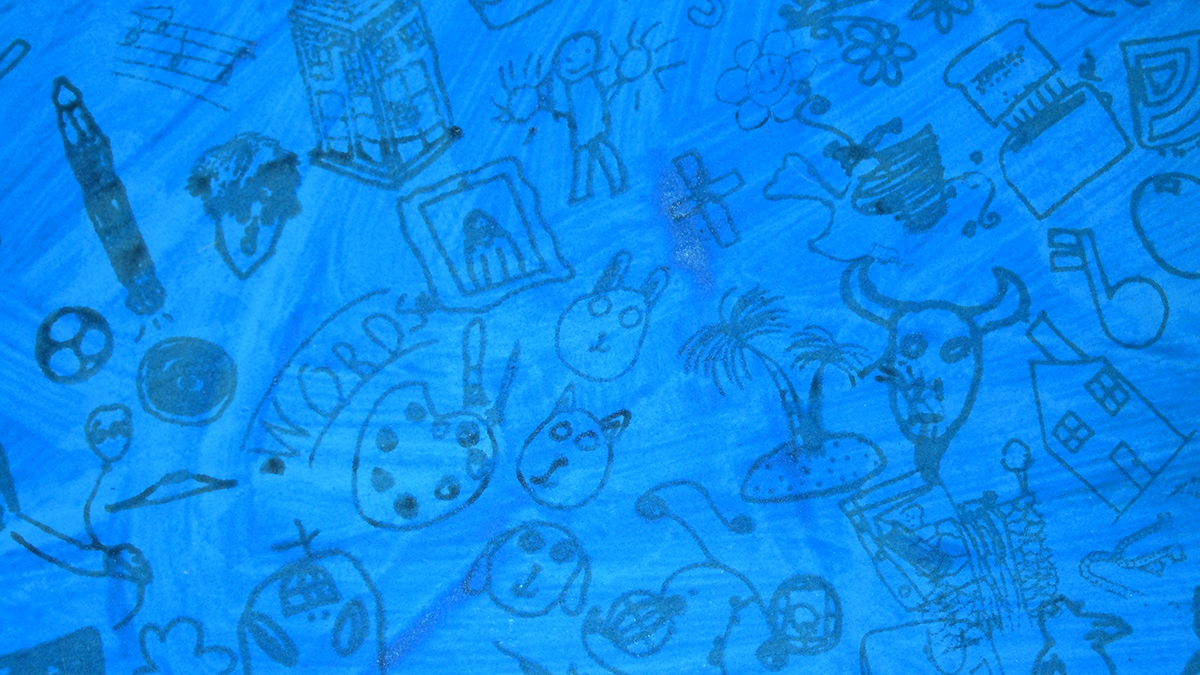 Part of not having a big ego is being able to accept negative feedback. Expect that someone will tell you they don’t like the art. Rather than get defensive, invite them to describe why they feel as they do. The conversation can result in wonderful dialogs.
Part of not having a big ego is being able to accept negative feedback. Expect that someone will tell you they don’t like the art. Rather than get defensive, invite them to describe why they feel as they do. The conversation can result in wonderful dialogs.
When forming a liturgical arts team, “Be clear about how decisions will be made. Put someone in charge who is liturgically grounded and has leadership and team building experience. Arts teams have to be integrated with music teams, worship planners and preachers. Define how funds will be found and used and where and how art will be stored,” she says.
It’s also good in church art projects to look for people whose gifts have yet to be engaged, like those skilled at working in metal, wood or leather or in upcycling materials that others would discard.
“Look for problem solvers, whether engineers or others who are used to working with others. Invite people not just for their creative gifts but also for their relational style and emotional maturity. You want to find people who feel the ego collectively, not individually. Celebrate what each team member does from the perspective of how their contributions enhance Christian worship,” she says. (Photo: Holy, Wholly, Whole doodles. Photo by Phil and Linda Henke.)
Links
LEARN MORE
Linda Witte Henke is scaling way back on doing commissions, collaborative projects, seminars and workshops. However, you can see more of her work on our website or book one of her traveling art exhibits. She also has work in several group traveling exhibits organized by Christians in the Visual Arts (CIVA). See more photos from her “Bound Together” weaving project.
Learning more about liturgical seasons in the Christian Year or studying your worship space may spark ideas for your visual arts projects. Linda Witte Henke gives complete directions for 20 visual arts projects in Sundays and Seasons: Guide to Worship Planning/Year C, 2016.
Check out this article on seven easy cross-themed art projects for participatory worship.
Find artists who accept commissions by exploring Collaboration of Design + Arts liturgical award winners and the Episcopal Church & Visual Arts registry.
START A DISCUSSION
Feel free to print and distribute these stories at your staff, education or worship arts meeting. These questions will help people start talking about working together on visual arts projects for worship:
- Share a story of a visual arts worship experience that touched you or changed you without words.
- Whose gifts have you not yet tapped in creating visual arts for worship?
- What are the pros and cons of integrating visual arts with the liturgical seasons of the Christian Year?

